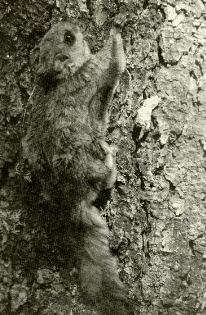
by: Shawn Gerrow
WINTER 1993/94
Many people frequent the woods during the day, but few are there at night. If you quietly walk through an older forest after dark, you might hear a high pitched "pisp pisp pisp" sound. If you are lucky, you may even catch a glimpse of something gliding off into the darkness; a flying squirrel. These secretive animals only venture out of their nests after dark and return to their home at dusk. This reason, and the fact they require a specific habitat, are why few people see flying squirrels.
Nova Scotia has two species of flying squirrels: the northern flying squirrel (Glaucomys sabrinus) and the southern flying squirrel (Glaucomys volans). Both species are nocturnal, but differ in size, pelage, and behaviour. Northern flying squirrels are found throughout the province. The smaller southern flying squirrel is found only in two areas: the Gaspereau valley and Kejimkujik National Park.
Most people are familiar with the common red squirrel, but northern flying squirrels look quite different. They are about three-quarters the size of a red squirrel and weigh half as much. Flying squirrels are a mixture of tan, cinnamon, and beige in colour, with a white underside. Their face and the end of their tail are grey. They have large eyes and can see extremely well in the dark. This is not surprising given their nocturnal nature and mode of locomotion. Flying squirrels are gentle and mild mannered, but they will scold you in a whiny voice when they are handled.
The unique features that enable these squirrels to fly include a large flat tail and a gliding membrane. The membrane is a fold of skin that is completely furred and stretches from wrist to ankle. In order to glide, flying squirrels leap from trees and extend their limbs to form a kite as the membrane is extended. The tail acts as a rudder, provides extra lift, and is used to stabilize the squirrel while gliding. Flying squirrels are exceptionally agile in flight, capable of glides up to 100 metres. They are able to turn, gain altitude, avoid branches and make soft landings on the trunk of a tree.
Flying squirrels breed in March and April, and their young are born in May and June. Litters range in size from 1 to 4, with 2 being the common number. At birth, young flying squirrels weigh only a few grams and are blind and hairless. By the end of August, most have reached adult weight. Young are distinguished from adults by their grey colour, until they moult into their winter coat in October.
Two types of nests are used by flying squirrels; cavity and dray (outside nests). Cavity nests are found in snags and trees with dead or broken branches. The cavities are formed naturally or they were created by small woodpeckers, such as the hairy or downy woodpecker. Flying squirrels can be found in the day by tapping on snags with natural cavities or woodpecker holes. Dray nests are made in witches broom, dense conifer branches, and where large branches meet the tree trunk (fork). These nests consist of a tangled ball of shredded bark, moss and old man's beard, and are similar to those use by red squirrels. Both cavity and outside nests have finely-shredded bark from birches in the interior that is used as bedding. More than one nest is used by individual squirrels, and nests seem to be community property since they are often used by different individuals on different days. Groups of flying squirrels are commonly found together in the same nest. Apparently, they are very social and tolerant of each other.
Fungi, such as mushrooms and truffles, appear to be their most important food source. The seeds of birches and berries are also eaten when in season. For an animal of its small size, flying squirrels can travel quite far, up to 500 metres or more from their nests. Home ranges overlap, so squirrels often forage in close proximity to one another and sometimes can be found feeding in the same place.
Flying squirrels' habitats are found in tall trees, snags, decomposing logs and relative understorey, which offer excellent gliding opportunities. Fungi are more abundant in forests with decomposing logs. Snags are used for nest sites. These habitat characteristics are generally found in older forests. Since older forests are becoming increasingly rare, flying squirrels are distributed in patches.
Northern flying squirrels are very important to the ecology of forests in western North America. Some fungi that they eat form their fruiting bodies underground. These fungi form a symbiotic relationship with tree roots, and as such help plants obtain nutrients they would otherwise have been unable to procure. By digging up fungi and eating them, flying squirrels help spread their spores. The spores pass through the squirrels digestive tract unharmed and inoculate the roots of young plants.¹
It is not known if flying squirrels make the same contribution to the forest community of Eastern Canada. However, if this is the case, then the ecological integrity of our forests may not be the same without the flying squirrel.

¹: The discussion on fungi ecology is based on the following report: Maser, C and Maser, Z. 1988. Interactions among squirrels, mycorrhizal fungi, and coniferous forests in Oregon. Great Basin Naturalist 48:358-369.